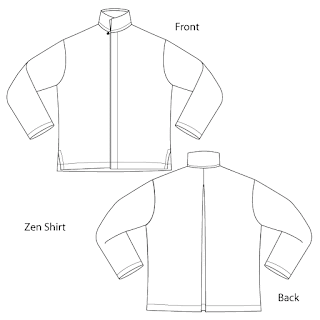This one is all about the fabric. It is a medium weight Japanese cotton I purchased from Louise Cutting at the Atlanta Expo in March. I purchased 1.5 yards and it is 45 inches wide. What was I thinking?! I just barely squeezed out this version of the Zen jacket pattern from the Sewing Workshop.
 |
| (It looks like the left front curves down but that is just a shadow. The front hem is even on both sides.) |
So I had to choose my pattern carefully and manage the fabric as efficiently as I could without sacrificing the distinctive print. The Zen jacket has an inverted pleat in the back. That was the first thing to go. I also narrowed the fronts by creating plackets down the center fronts. For this I used a cotton-linen in black and gray check. I also cut off the sleeve hems and created facings using the same black and gray check.
The Zen jacket includes a two-layer collar. There was enough left after cutting the main pieces to cut one collar piece, so I cut a second one from the black and gray check. I tested this arrangement and decided it was just too much. I felt that the fabric demanded a less cluttered pattern, so I omitted the collar and finished it with a bias binding in the black and great check instead.
The front plackets created an opportunity for in-seam button holes, a little bit of a kluge but I like the result.
The sleeve hem facings I created were about 5 inches deep so that I could roll up the sleeves and see the contrasting piece. As I began to assemble it, I decided to take advantage of the depth of the facings and created a vent in each sleeve. These too can be rolled up or left down.
But my facing assembly created a weak spot in the construction right where the facing intersects the vertical sleeve seam. That's right at the top of the vent. So I appliqued a small square of the black and gray check to the weak spot.
I am not sure if this will be a shirt or a jacket, so I used a Hong Kong finish on (most of) the interior seams.
Initially I machine hemmed the sleeves and the garment hem. The result was not pretty. It was OK but it spoiled the pattern. So I pulled it out and hemmed with sashiko.
Just a little more sashiko and it is now finished.


































